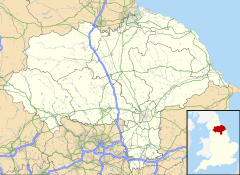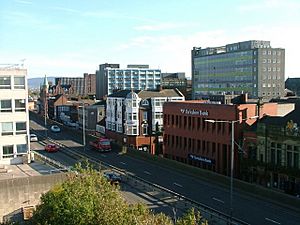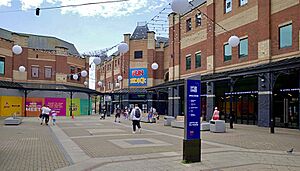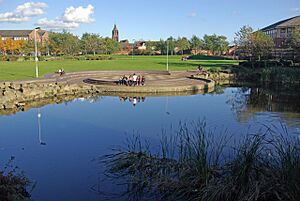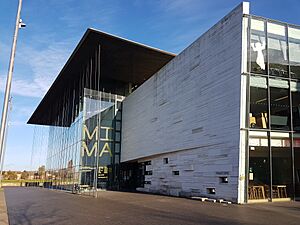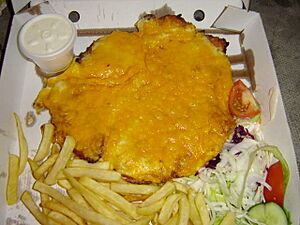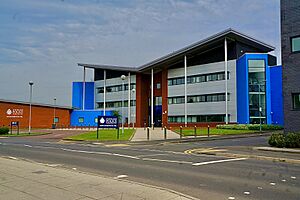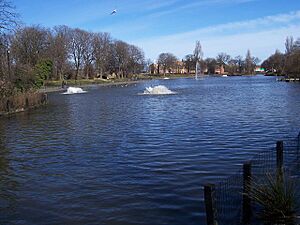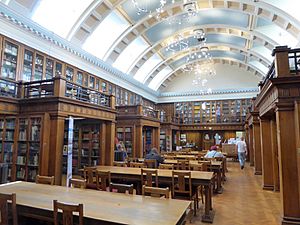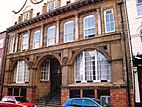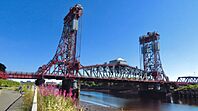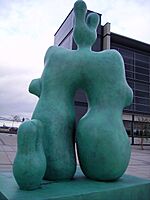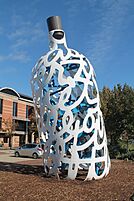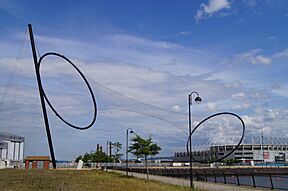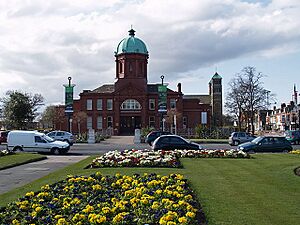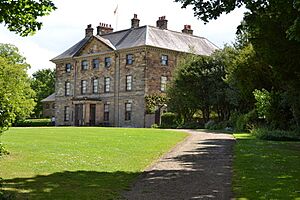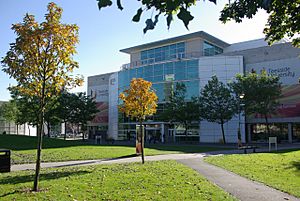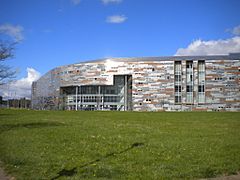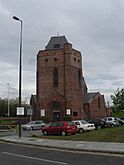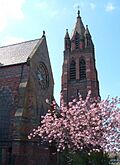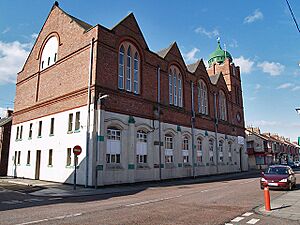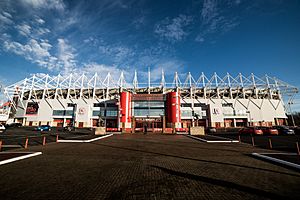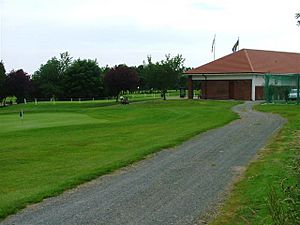Middlesbrough facts for kids
Quick facts for kids Middlesbrough |
|
|---|---|
| Town | |
|
Skyline of the town centre
Linthorpe Road
The Transporter & the Hydraulic Clock Tower
Teesside University's Waterhouse Building
Middlesbrough Town Hall
|
|
| Population | |
| • Borough (2020) | 140,980 |
| • Built-up area (2021) | 148,215 |
| Demonym | Smoggie (colloquial) |
| OS grid reference | NZ495204 |
| • London | 217 mi (349 km) S |
| Unitary authority | |
| Ceremonial county | |
| Region | |
| Country | England |
| Sovereign state | United Kingdom |
| Post town | MIDDLESBROUGH |
| Postcode district | TS1 – TS9 |
| Dialling code | 01642 |
| Police | Cleveland |
| Fire | Cleveland |
| Ambulance | North East |
| EU Parliament | North East England |
| UK Parliament |
|
Middlesbrough (![]() i/ˈmɪdəlzbrə/ mid-ƏLZ-brə), often called Boro, is a port town in North Yorkshire, England. It sits south of the River Tees and is part of the larger Teesside area.
i/ˈmɪdəlzbrə/ mid-ƏLZ-brə), often called Boro, is a port town in North Yorkshire, England. It sits south of the River Tees and is part of the larger Teesside area.
Middlesbrough was a small farming village until 1830. Then, the Stockton and Darlington Railway expanded, and the town grew quickly. It became a major center for heavy industry in the 1800s. Later, in the late 1900s, many of these industries closed down.
The town has been part of Yorkshire for a very long time. In 1853, Middlesbrough became a town with its own local government. In 1996, it became a unitary authority, meaning it manages its own local services. Since 2016, it has been part of the Tees Valley Combined Authority, which helps with regional development.
Contents
- History of Middlesbrough
- How Middlesbrough is Governed
- Geography of Middlesbrough
- Middlesbrough's Economy
- Culture in Middlesbrough
- Public Services
- Facilities in Middlesbrough
- Landmarks of Middlesbrough
- Transport in Middlesbrough
- Education in Middlesbrough
- Religion in Middlesbrough
- Media and Entertainment
- Sports in Middlesbrough
- Notable People from Middlesbrough
- Twin Towns
- See also
History of Middlesbrough
From Monks to a Growing Town
Middlesbrough began as a Benedictine priory, which was a type of monastery. It was located on the south bank of the River Tees. Its name might mean "middle fortress" because it was halfway between two important religious places: Durham and Whitby.
In 686, St. Cuthbert started a small religious community here. This community grew into Middlesbrough Priory. The land around Middlesbrough belonged to Whitby Abbey. In 1119, Robert Bruce gave the church of St. Hilda of Middleburg to Whitby. Monks looked after the church until 1537, when Henry VIII closed all monasteries.
After the Anglo-Saxons, Vikings settled in the area. Many local place names, like Ormesby and Stainsby, come from Viking words. These villages were mentioned in the Domesday Book of 1086.
The Rise of Coal and Docks
In 1801, Middlesbrough was a tiny farming village with only 25 people. But it started to grow very fast from 1829. In 1828, Joseph Pease, a Quaker banker and coal mine owner, looked for a new place to load coal onto ships.
In 1829, Pease and other Quaker businessmen bought land and started the Middlesbrough Estate Company. They built a new coal port, called "Port Darlington," on the River Tees. A village grew up nearby to house the port workers, taking the name Middlesbrough.
The port was connected to the Stockton and Darlington Railway in 1830. The port became so busy that a larger dock was needed. Work on this new dock began in 1839 and it officially opened in 1842.
Iron, Steel, and Shipbuilding
Iron became very important in the Tees area in 1841. That's when Henry Bolckow and John Vaughan started their iron foundry, Vulcan Foundry. They used a new system for blast furnaces and found lots of Ironstone in the nearby Eston Hills. This made their business very successful. The area became known as the "Iron-smelting centre of the world."
By 1851, Middlesbrough's population had jumped from 40 to 7,600 people. By the mid-1870s, Middlesbrough was making one-third of all the Pig iron in Britain! This is why it earned the nickname "Ironopolis."
On January 21, 1853, Middlesbrough received its Royal Charter. This meant the town could have its own mayor and council. Henry Bolckow became the first mayor.
As the town grew, new buildings were put up around the new town hall. In 1900, Bolckow, Vaughan & Co became the largest steel producer in Great Britain. The town's population reached 90,000 by the early 1900s.
Middlesbrough in World War II
Middlesbrough was the first major British town and industrial area to be bombed during World War II. The German air force, the Luftwaffe, targeted the steel factories and railways. The first bombing happened on May 25, 1940.
More bombs fell throughout the war. The railway station was out of action for two weeks in 1942. By the end of the war, over 200 buildings in Middlesbrough were damaged or destroyed. Many old Victorian houses were pulled down, and the town center was rebuilt.
Post-War Changes and Growth
After the war, Middlesbrough changed a lot. New roads were built, like the A66 road in the 1980s. Some old buildings, like the Royal Exchange, were demolished to make way for these changes.
Middlesbrough F.C.'s modern Riverside Stadium opened in 1995 next to Middlesbrough Dock. The club had played at Ayresome Park for 92 years before moving.
The old St. Hilda's area, which had declined, was renamed Middlehaven in 1986. New buildings like Middlesbrough College and the Riverside Stadium were built there. Middlehaven also has the "Boho" zone, which offers office space for new businesses, especially in the digital sector.
Middlesbrough continued to expand, taking in nearby villages like Linthorpe and Acklam.
How Middlesbrough is Governed
Middlesbrough is managed by Middlesbrough Council, which is a unitary authority. This means it handles most local services itself. It is also part of the Tees Valley Combined Authority, which works on bigger projects across the region.
Local Government History
Middlesbrough started as a small area within the parish of West Acklam. After the monasteries closed, the old priory church was used for a while.
In 1841, a group of commissioners was set up to manage improvements in the growing town. In 1853, Middlesbrough officially became a municipal borough. Its boundaries grew several times. In 1889, it became a county borough, which meant it was independent from the larger county council.
The borough continued to expand, taking in nearby areas like Linthorpe and North Ormesby. In 1968, Middlesbrough became part of the Teesside County Borough. Then, in 1974, it became part of the new county of Cleveland. When Cleveland county was abolished in 1996, the Borough of Middlesbrough became a unitary authority within North Yorkshire.
Political Representation
Middlesbrough has two Members of Parliament (MPs) who represent the town in the UK Parliament. The Middlesbrough constituency is currently represented by Andy McDonald from the Labour Party. The Middlesbrough South and East Cleveland constituency is represented by Simon Clarke from the Conservative Party.
Historically, Middlesbrough has often elected Labour MPs.
Geography of Middlesbrough
Middlesbrough is located south of the River Tees. On the opposite bank, you can find nature reserves and industrial sites. The town has green spaces like Sandy Flatts, Middlesbrough Municipal Golf Course, Stewart Park, and Ormesby Hall's grounds. It is recognized as one of the Tree Cities of the World.
Distances to Other Places
| Place | Distance | Direction | Relation |
|---|---|---|---|
| London | 217 miles (349 km) | South | England and the UK's capital city |
| Edinburgh | 158 miles (254 km) | North | Scotland's capital city |
| York | 43 miles (69 km) | South | Historic county town of Yorkshire |
| Durham | 19 miles (31 km) | North | Closest city |
| Darlington | 13 miles (21 km) | West | Teesdale |
| Hartlepool | 8 miles (13 km) | North | Teesdale |
| Stockton | 3 miles (4.8 km) | West | Teesdale |
The town center is about 6 miles (10 km) from the coast. It's also close to nature, being 7 miles (11 km) from Roseberry Topping in the North York Moors National Park. The Yorkshire Dales National Park is about 25 miles (40 km) away.
Areas within Middlesbrough
Middlesbrough is part of the Teesside area, which includes nearby towns like Stockton and Redcar. The town is divided into different wards or areas. Some of these areas, like Nunthorpe and Stainton, were once separate villages.
Middlesbrough's Climate
Middlesbrough has an oceanic climate, which is typical for the United Kingdom. It's one of the drier parts of the country, getting about 574 mm (22.6 inches) of rain each year.
Temperatures are usually mild. In July and August, summer highs are around 21°C (70°F). In December and January, winter lows are around 0°C (32°F). The weather doesn't change too much between seasons. This is because Britain is an island surrounded by water, and warm air from the Atlantic Ocean keeps temperatures from getting too extreme.
Middlesbrough's Economy
Middlesbrough has several shopping centers, including Cleveland Centre, Hill Street, Captain Cook Square, and Dundas. There are also retail parks like Gateway Retail Park and the Parkway Centre.
For entertainment, there's a cinema and bowling alley at Teesside Park. Middlesbrough Leisure Park also has restaurants, a cinema, and a gym. Captain Cook Square has recently added fun activities like mini-golf, an indoor go-kart track, and an e-sport venue.
Industry in Middlesbrough
In the past, Middlesbrough's economy was mainly based on steelmaking, shipbuilding, and chemical industries. While some heavy industry remains, newer technologies, especially in the digital sector, have become more important.
Engineering
Middlesbrough is still strong in engineering and manufacturing. The new TeesAMP (advanced manufacturing park) is being built to support businesses that use advanced manufacturing and new technologies. In 2020, it was announced that TeesAMP would be home to the UK's first hydrogen transport center.
The Port
Teesport, owned by PD Ports, is a very important part of Middlesbrough's economy. The port is only 1 mile (1.6 km) from the North Sea. In 2019, it handled over 4,350 ships and about 27 million tonnes of cargo. Teesport supports industries like steel, petrochemicals, manufacturing, and renewable energy.
Past Industries
In 1875, Bolckow, Vaughan & Co started the Cleveland Steelworks, shifting from iron to steel production. By the early 1900s, Middlesbrough was one of the world's major steel centers. In 1900, Bolckow, Vaughan & Co was the largest steel producer in Britain. Later, Dorman Long, another big steel company, took over Bolckow, Vaughan & Co.
Dorman Long was famous for building bridges. They engineered and made the steel for the Sydney Harbour Bridge (1932) and the Tyne Bridge in Newcastle upon Tyne.
Many large shipyards also operated along the River Tees. One of them, Sir Raylton Dixon & Company, built hundreds of steamships, including the SS Mont-Blanc, which caused the huge 1917 Halifax Explosion in Canada.
The Wilton International industrial site nearby was once largely owned by Imperial Chemical Industries (ICI). Now, smaller companies operate there.
Culture in Middlesbrough
Festivals and Events
The Middlesbrough Mela is a yearly festival that celebrates different cultures. It attracts up to 40,000 people with live music, food, crafts, and fashion. It's usually held in Albert Park or Centre Square.
Theatres and Music Venues
Middlesbrough has a rich musical history. Famous musicians like Paul Rodgers and Chris Rea are from the area.
Middlesbrough Town Hall is a main venue for performances. It has a large concert hall that seats 1,190 people and a smaller venue called the Middlesbrough Crypt. The Town Hall was renovated and reopened in 2018.
The Middlesbrough Theatre (formerly the Little Theatre) is in Linthorpe. It opened in 1957 and was one of the first new theaters built in England after World War II.
Art and Galleries
The town has three art galleries. The Middlesbrough Institute of Modern Art, or mima, is a modern art gallery that opened in 2007.
The Middlesbrough Art Weekender is a contemporary art festival held in central Middlesbrough since 2017. The Auxiliary Warehouse space also hosts art events.
Platform A Gallery is a unique art space located at Middlesbrough Railway Station.
Local Food
The Parmo is a famous dish that started in Middlesbrough. It's a breaded piece of meat, usually chicken or pork, topped with cheese and a white sauce. You can find parmos at many takeaways in Middlesbrough.
Public Services
Healthcare
The James Cook University Hospital is a major hospital in Middlesbrough. It's part of the South Tees Hospitals NHS Foundation Trust. The hospital also helps the economy by supporting new research and technology projects.
Roseberry Park Hospital is a psychiatric hospital located near James Cook Hospital. There are also other medical centers like Middlesbrough One Life Medical Centre.
Police Services
Cleveland Police serves Middlesbrough from its headquarters on Bridge Street West. The British Transport Police also have a presence at Middlesbrough Station.
Facilities in Middlesbrough
Parks and Green Spaces
Albert Park was given to the town by Henry Bolckow in 1866. It's a large park that was restored between 2001 and 2004.
Stewart Park was donated in 1928. It has Victorian buildings, lakes, and animal pens. It's also home to the Captain Cook Birthplace Museum. The park hosted the BBC Radio 1's Big Weekend in 2019.
Newham Grange Leisure farm in Coulby Newham has been a farm since the 1600s. It's now a farm park and conservation center.
Libraries
Middlesbrough has several libraries. The Middlesbrough Central Carnegie library is a notable one, built in 1912.
Landmarks of Middlesbrough
As of 2022, Middlesbrough has 129 listed buildings. Acklam Hall is the most important, listed at Grade I. Eleven others are Grade II*, including the town hall and the Transporter Bridge.
Important Buildings
Acklam Hall, Grey Towers, Webb House/ The Dorman Long Office and The Middlesbrough Empire
The terraced Victorian streets around the town center show Middlesbrough's history and how quickly it grew during the industrial era.
The outer parts of the town have many old country halls, mostly from the Victorian period. Some, like Marton Hall, no longer exist. But others, like Newham Hall and Acklam Hall (built in 1678), are still standing.
Middlesbrough Town Hall, built between 1883 and 1889, is a Grade II* listed building. It's used for council meetings and as an entertainment venue. The Middlesbrough Empire, built in 1897 as a theater, is now a nightclub. The Middlesbrough Theatre in Linthorpe opened in 1957 and was one of the first new theaters in England after the war.
The Dorman Long office on Zetland Road, built between 1881 and 1891, is the only commercial building designed by the famous architect Philip Webb.
Famous Bridges
The Tees Transporter Bridge was built in 1911 by Sir William Arrol & Co.. It crosses the river between Middlesbrough and Port Clarence. It's a Grade II* listed building. Parts of the film Billy Elliot were filmed on this bridge. It's one of the largest bridges of its kind in the world, being 850 feet (259 m) long and 225 feet (69 m) high.
The Tees Newport Bridge opened in 1934 further up the river. It can still be used by traffic.
Public Artworks
The Temenos Sculpture is a large steel structure near the Riverside Stadium. Designed by Anish Kapoor and Cecil Balmond, it's about 110 m long and 50 m high. It was unveiled in 2010.
Near the town hall is the "Bottle of Notes" sculpture. Unveiled in 1993, it's the only public sculpture in the UK by Claes Oldenburg. The sculpture is covered in text from the journals of Captain James Cook, who was born nearby.
Transport in Middlesbrough
Air Travel
The closest international airports to Middlesbrough are Teesside, Newcastle, and Leeds Bradford. You can reach them by train, usually with one change. Manchester Airport has a direct train service.
Railway Connections
Middlesbrough railway station is a busy station that opened in 1877. It's built in the Gothic style. It's the end point for the Esk Valley line and the Durham Coast line, and it's on the Tees Valley line.
Three train companies serve the station:
- Northern runs local trains to places like Newcastle, Sunderland, and Whitby.
- TransPennine Express offers services to Leeds, York, and Manchester Airport.
- LNER has limited services to London Kings Cross.
Other train stations in Middlesbrough include Nunthorpe, Gypsy Lane, Marton, and James Cook (near the hospital).
Bus Services
Arriva North East and Stagecoach North East provide most of the local bus services. For longer journeys, National Express and Megabus coaches operate from Middlesbrough bus station.
Road Network
Middlesbrough is connected by several major roads:
- The A19 runs north-south to the west of the town.
- The A66 runs east-west through the northern part of the town center.
- Other main routes include the A171, A172, and A174.
Walking and Cycling Paths
Several long-distance walking paths pass near Middlesbrough. The Teesdale Way goes through the town. The Coast to Coast Walk is a planned national trail that will pass nearby.
Two paths, the Cleveland Way and the White Rose Walk, include Roseberry Topping.
Education in Middlesbrough
Museums to Visit
The Dorman Memorial Museum, founded by Arthur Dorman, focuses on local history and social life.
The Captain Cook Birthplace Museum opened in 1978. It celebrates the 250th anniversary of Captain James Cook's birth in nearby Marton.
Just outside Middlesbrough's boundary is Ormesby Hall. This 18th-century mansion, once owned by the Pennyman family, is now a National Trust property.
The Transporter Bridge Visitor Centre opened in 2000 to celebrate the Middlesbrough Transporter Bridge.
Teesside University
Teesside University started in 1930 as Constantine Technical College. It grew by adding more buildings and became Teesside Polytechnic in 1969.
In 1992, it became the University of Teesside, and in 2009, it was rebranded as Teesside University. It has about 20,000 students and 2,400 staff. The university has invested around £250 million in its campus in Middlesbrough town center.
The university is well-known for developing digital businesses, especially in digital animation. It hosts the annual Animex festival. Many new digital businesses are located in the Boho zone in town, thanks to the university's support.
Teesside University helps create many jobs and adds a lot of money to the local and national economy. It has departments for business, arts, computing, health, science, engineering, and social sciences.
Other Educational Places
Middlesbrough's largest college is Middlesbrough College, with 16,000 students. Other colleges include Trinity Catholic College and Macmillan Academy. Askham Bryan College also has a site in Stewart Park.
The Northern School of Art (established in 1870) is also based in Middlesbrough. It's one of only four special art and design colleges in the UK.
Religion in Middlesbrough
Christianity
Middlesbrough is part of the Church of England's Diocese of York. It also has a Roman Catholic Diocese, with St. Mary's Cathedral in Coulby Newham as its main church. There are also several other Christian churches in the town.
Judaism

Ashkenazi Jews began settling in Middlesbrough in 1862. They formed the Middlesbrough Hebrew Congregation in 1870 and had a synagogue in Hill Street. The Jewish population grew to 750 people in 1935 but later declined. The synagogue in Park Road South closed in 1998.
Islam
The Muslim community in Middlesbrough has several mosques. Muslim sailors started visiting Middlesbrough around 1890. The first Halal butcher shop opened in 1961. The first mosque was in a house in Grange Road in 1962. Today, there are mosques like the Al-Madina Jamia Mosque and the Abu Bakr Mosque.
Sikhism
The Sikh community opened its first gurdwara in Milton Street in 1967. The current center in Lorne Street opened in 1990.
Hinduism
There is a Hindu Cultural Centre in Westbourne Grove, North Ormesby, which opened in 1990.
Media and Entertainment
Local news and TV programs for Middlesbrough come from BBC North East and Cumbria and ITV Tyne Tees. There's also a local TV station called TalkTeesside.
Local radio stations include BBC Radio Tees, Heart North East, and Hits Radio Teesside. Middlesbrough is also served by the local newspaper, Evening Gazette.
Middlesbrough in TV and Film
Middlesbrough has been featured in many TV shows, such as The Fast Show, Inspector George Gently, and Auf Wiedersehen, Pet.
Film director Ridley Scott, who is from the North East, said the opening scene of his film Blade Runner was inspired by the view of the old ICI plant at Wilton.
In the 2009 action movie The Tournament, Middlesbrough is the setting for an assassins' competition. In 2009, the mima art gallery was used by the presenters of Top Gear for a challenge.
In 2010, filmmaker John Walsh made a documentary called ToryBoy The Movie about the 2010 general election in the Middlesbrough area.
Sports in Middlesbrough
Football and Rugby
Middlesbrough FC is a professional football team that plays in the EFL Championship. They play their home games at the 34,000-seat Riverside Stadium, which they moved to in 1995. Middlesbrough was one of the founding members of the Premier League in 1992. They won the Football League Cup in 2004 and were finalists in the 2005-06 UEFA Cup. In 1905, they made Britain's first £1,000 transfer when they signed Alf Common.
Middlesbrough RUFC, a rugby union club founded in 1872, plays its home games at Acklam Park.
Racing Events
Middlesbrough hosts several road races each year, including the annual Middlesbrough 10k road race. In 2016, Middlesbrough was the starting point for Stage 3 of the 2016 Tour de Yorkshire cycling race.
Other Sports
Middlesbrough Cricket Club plays at Acklam Park. Yorkshire has played many games in Middlesbrough.
Speedway racing used to be held at Cleveland Park Stadium until the 1990s.
Basketball teams like Tees Valley Mohawks and Teesside Lions play in the NBL Division 3. The Middlesbrough Sports Village, which opened in 2015, offers facilities for athletics, football, cycling, and more. It replaced Clairville Stadium. Famous athletes like Richard Kilty and Chris Tomlinson have trained there. The sports village also has a skateboard park and Middlesbrough Tennis World.
Notable People from Middlesbrough
Many famous people come from Middlesbrough. You can find a list of them at List of people from Middlesbrough.
Twin Towns
Middlesbrough is twinned with:
- Oberhausen, Germany: This partnership began in 1974, but close ties and youth exchanges started much earlier in 1953.
- Dunkirk, France: Although officially twinned, twinning events have stopped.
- Masvingo, Zimbabwe: Twinned since 1989.
See also
 In Spanish: Middlesbrough para niños
In Spanish: Middlesbrough para niños








